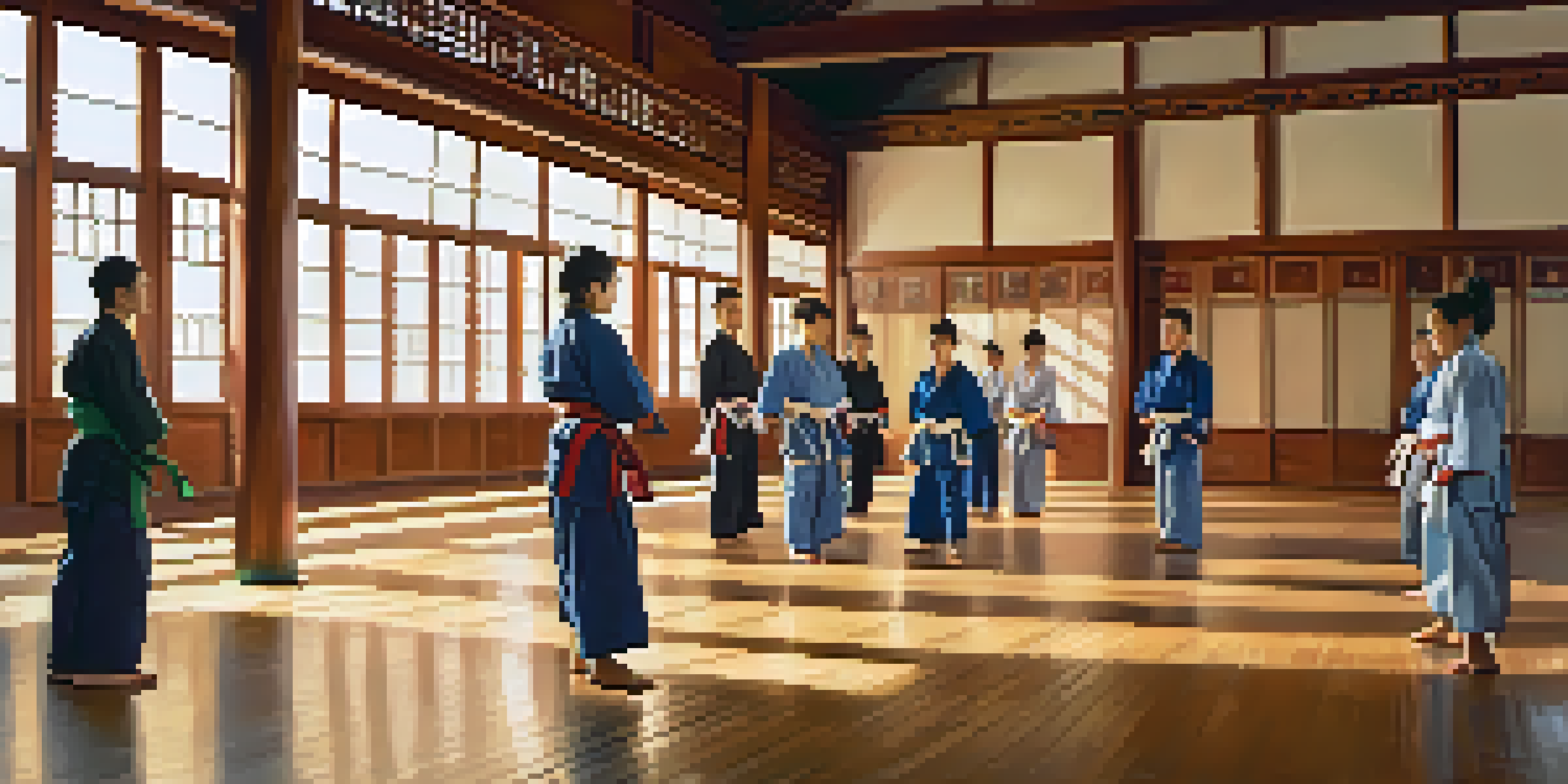Martial Arts Techniques for Effective Conflict Resolution Skills

Understanding the Basics of Conflict Resolution
Conflict resolution is the process of resolving a dispute or disagreement. It involves understanding the perspectives of all parties involved and finding a mutually acceptable solution. Just like martial arts, effective conflict resolution requires a blend of strategy, patience, and communication skills.
The greatest victory is that which requires no battle.
At its core, conflict resolution is about maintaining respect and empathy, which are also key principles in martial arts. By learning how to listen actively and communicate clearly, you can defuse tension before it escalates. This approach parallels martial arts techniques, which emphasize awareness and control over one’s actions and reactions.
Practicing conflict resolution can lead to more peaceful interactions, whether in personal relationships or professional environments. When you approach conflicts with a mindset of cooperation, like a martial artist does in training, you open the door for constructive conversations and outcomes.
The Importance of Awareness in Conflict Situations
Awareness is a fundamental principle in martial arts, as practitioners are trained to be aware of their surroundings and the movements of their opponents. This same awareness can play a crucial role in conflict resolution. By being attuned to the emotions and body language of those around you, you can better assess the situation and respond effectively.

For instance, if you notice someone becoming increasingly agitated, you can use your awareness to adjust your tone and approach accordingly. By recognizing the signs of rising tension early, you can intervene before the situation escalates, much like a martial artist who anticipates and counters an opponent's moves.
Empathy Enhances Conflict Resolution
Understanding others' feelings fosters collaboration and effective communication during disputes.
Incorporating this level of awareness into everyday interactions can transform how you approach conflicts. Just as a martial artist trains to refine their skills, you can practice being present and engaged, ultimately leading to more peaceful resolutions.
Utilizing Breathing Techniques for Calmness
Breathing techniques are essential in martial arts, not just for physical stamina, but also for mental clarity. Deep, controlled breathing can help manage stress and anxiety during a conflict. By taking a moment to breathe deeply, you can collect your thoughts and approach the situation with a clearer mindset.
In the midst of movement and chaos, keep stillness inside of you.
In tense moments, remember that your breath can be a powerful tool. Just like martial artists use breathing to center themselves before executing a technique, you can use it to ground yourself during discussions. This practice can help prevent knee-jerk reactions that might escalate conflicts.
Integrating breathing exercises into your routine can enhance your ability to stay calm under pressure. Whether it’s a few deep breaths before responding to a heated comment or practicing mindfulness through meditation, these techniques can greatly improve your conflict resolution skills.
The Role of Empathy in Resolving Disputes
Empathy is a vital component of both martial arts and conflict resolution. Understanding the feelings and perspectives of others allows for more effective communication and problem-solving. Just as martial artists are trained to respect their opponents, you can cultivate empathy to foster a more collaborative environment.
When you approach a conflict with empathy, you create a space for open dialogue. This mirrors how martial artists often engage in sparring with a partner to learn and grow together. By acknowledging the other person’s feelings, you can work toward a resolution that honors both parties’ needs.
Awareness is Key in Conflicts
Being attuned to emotions and body language helps in effectively managing and de-escalating tensions.
Practicing empathy may require stepping outside your own viewpoint and considering how the other person feels. This shift can be transformative, turning a potential confrontation into an opportunity for connection and understanding.
Effective Communication Techniques from Martial Arts
Communication is key in any conflict resolution scenario, and martial arts techniques can enhance your dialog skills. Just as martial artists learn to convey their intentions clearly through movements, you can practice expressing yourself effectively during disputes. This includes being assertive without being aggressive.
Using 'I' statements, such as 'I feel' or 'I need,' can help communicate your feelings without placing blame. This technique is akin to a martial artist delivering a precise strike rather than a wild flurry. Clear communication helps to minimize misunderstandings and allows for a more productive discussion.
When you embrace effective communication techniques, you set the stage for resolution. By ensuring that both parties feel heard and understood, you pave the way for collaborative problem-solving, much like a martial artist who practices with a partner to improve their skills.
Learning to Let Go: A Martial Arts Philosophy
One of the core philosophies of martial arts is the ability to let go of attachments, whether they be to outcomes or grudges. This principle is invaluable in conflict resolution as it encourages you to release the need to 'win' an argument. Instead, focus on the goal of finding common ground.
By letting go, you create an opportunity for healing and understanding. It’s similar to how martial artists learn to accept defeat in sparring as a chance to grow. When you practice letting go, you free yourself from the weight of resentment and open yourself up to constructive dialogue.
Letting Go Facilitates Healing
Releasing the need to 'win' arguments allows for constructive dialogue and promotes mutual understanding.
Incorporating this mindset into your conflict resolution approach can lead to more harmonious relationships. Embracing the idea that it’s okay to compromise can lead to solutions that benefit everyone involved.
The Power of Visualization in Conflict Resolution
Visualization is a common practice in martial arts training, where athletes imagine themselves executing techniques successfully. This same technique can be applied to conflict resolution. By visualizing a positive outcome before entering a difficult conversation, you set a favorable tone for the interaction.
For example, if you anticipate a challenging discussion with a colleague, take a moment to visualize the conversation unfolding smoothly. This mental rehearsal can help reduce anxiety and prepare you to handle the situation with confidence, much like a martial artist who mentally prepares for a competition.

By incorporating visualization into your conflict resolution toolkit, you can approach discussions with a sense of calm and purpose. This practice not only boosts your confidence but also enhances the likelihood of achieving a positive outcome.
Putting It All Together: Embracing Martial Arts in Daily Life
Integrating martial arts techniques into your daily life can significantly enhance your conflict resolution skills. Begin by practicing awareness, empathy, and effective communication in your interactions, as these principles lay the foundation for constructive dialogue. Just like martial artists train consistently, you can refine these skills over time.
Consider enrolling in a martial arts class to deepen your understanding of these techniques. Even if you are not interested in physical training, the philosophies and mental practices can still be applied in your everyday life. The lessons learned in martial arts extend beyond the dojo and into your personal and professional relationships.
By embracing these principles, you cultivate a mindset of respect, understanding, and cooperation. Ultimately, this not only improves your ability to resolve conflicts but also contributes to a more peaceful and harmonious environment around you.